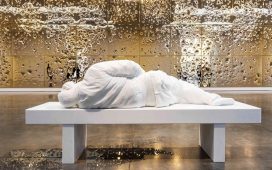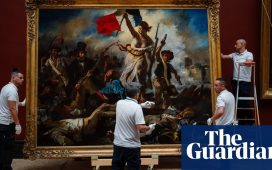It looks like a happy ending. After the disputes and all the agonising, Yinka Shonibare CBE offers a witty, weirdly beautiful conclusion to the debate over public statues that has raged since Edward Colston was toppled in Bristol four years ago. Except I don’t think Shonibare is interested in conclusions.
Queen Victoria, Winston Churchill, Kitchener – they’re all here, a gallery of famous and less famous icons of Britain’s imperial past. Their statues from public places in the capital have been reproduced, not monumental size but human height. They have also been removed from their plinths and brought down to earth. And each statue has been covered in the bright multicoloured Dutch wax prints that are Shonibare’s multicultural pop art trademark. These ravishing textiles, made in the Netherlands (and at one time Manchester) to sell in Africa since the 19th century and still doing a roaring trade, symbolise in Shonibare’s work the inauthenticity and complexity of culture and identity in a globalised capitalist world. Now they turn patriotic statues into something new and unimaginable to the dead people they represent.
Would Winston Churchill recognise himself? He stands covered in a pink and green wax print pattern that flows up from his greatcoat over his bald head, a funky psychedelic figure coloured with the heady forces that transformed Britain after his death in 1965. Downsized from his brooding bronze statue by Ivor Roberts-Jones that towers on a plinth in Westminster Square, Shonibare’s Winston is a kaleidoscopic dandy.
It’s a statue that should be bought by parliament, or at least the V&A, to remember the man who destroyed the British empire. Churchill, born 150 years ago, is today often denounced as a racist and imperialist. But a politician who put the British empire first in 1940 would have done as Hitler hoped and agreed to carve up the world with Nazi Germany, with Britain enjoying its global possessions while Germany enslaved eastern Europe. By fighting against any such peace, Churchill put world before nation and sacrificed Britain’s economy and power, making the end of empire inevitable.
Agree or not, we can talk about it. Shonibare’s joyous comic remake of public statuary lets you approach history with a rational detachment. Queen Victoria seems more alive covered in wax print flowers. Even Frederick Roberts, 1st Earl Roberts, mounted on horseback in a pith helmet, becomes disarmingly human here.
Who is he anyway? A celebrated, India-born Victorian general whose career started during the 1857 Indian Rebellion and took him to Afghanistan and the Boer war. The kind of colonial icon we’ve happily forgotten. Shonibare resurrects him in lurid reddish pink on a purple haze of a horse against the greening trees outside the Serpentine windows. To ponder and critique.
At a time when bad art is filled with passionate intensity, Shonibare is an ironist who encourages us to think a bit. The War Library is the most thought-provoking yet of a series of installations in which he fills bookshelves with wax-print-covered bespoke volumes. It’s a massive history of human warfare, covering conflicts from the Byzantine civil war to the second Anglo-Mysore war to the Parthian war of Caracalla. These bloody struggles, ancient and modern, famous and forgotten, are arranged without chronological or geographical hierarchy. The size and decorative flamboyance of a book doesn’t necessarily reflect the generally agreed significance of the war it encapsulates: the volume on the second world war is much slimmer than the one about the Ottoman-Persian war of 1743-46.
We are urged to rethink what matters, and where, in world history. Did Churchill and the Battle of Britain really shape our world more decisively than the Cherokee-American war or the second Habsburg-Valois war?
While you can’t remove and read its incongruously beautified volumes (what’s inside them anyway?), there is a study table in the centre of the gallery where you can explore a specially created digital encyclopedic history of warfare, with maps, chronologies and artistic depictions of conflict. At a time when once again wars are everyday news, Shonibare invites you to stand back, consider history, try to understand why war is such a recurring habit of our species.
There’s respite, however. Shonibare’s installation Sanctuary City is a moving ensemble of architectural models, lit from within against the dark. They include Notre Dame Cathedral, where Quasimodo famously sought “sanctuary!”. Fantastical colours burst from its gothic windows, like the hues of stained glass: but when you peek inside the model they turn out to be, once again, wax print patterns cunningly inserted and illuminated.
From Notre Dame to the modernist United Nations building in New York to the Chiswick Women’s Refuge, the buildings here glow with the idea of protecting vulnerable people. Except things are never so simple with Shonibare. Some of the apparently welcoming lights are cruelly deceptive. The Bibby Stockholm barge is a massive bleak presence in spite of the bright colours in its windows, a hulking reminder of Britain’s cold comfort for the asylum seekers who are sent there. It too will pass into history, like the British empire and the Fashoda Incident. Look it up in his library.








